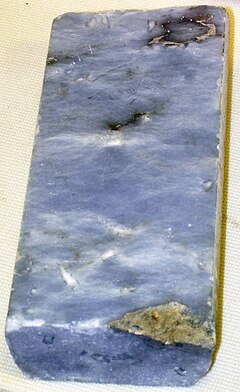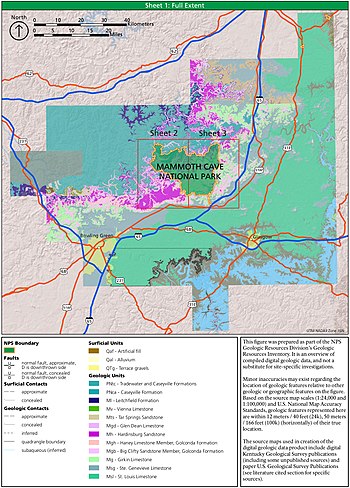St. Louis Limestone
Appearance
This article needs additional citations for verification. (August 2014) |
| St. Louis Limestone | |
|---|---|
| Stratigraphic range: Mississippian Sub-period | |
 Rock anhydrite (St. Louis Limestone; subsurface gypsum mine in Martin County, Indiana) | |
| Type | Geological formation |
| Unit of | Blue River Group |
| Sub-units | Dover Chert, Horse Cave Member, Sisson Member |
| Underlies | Ste. Genevieve Limestone |
| Overlies | Salem Formation[1] |
| Thickness | up to 100 feet (30 m)[2] |
| Lithology | |
| Primary | Limestone |
| Other | Shale, chert[2] |
| Location | |
| Region | Illinois, Indiana, Tennessee, Kentucky and Missouri |
| Country | United States |
| Type section | |
| Named for | St. Louis, Missouri[1] |
| Named by | Englemann |
| Year defined | 1847 |


The St. Louis Limestone is a large geologic formation covering a wide area of the midwest of the United States. It is named after an exposure at St. Louis, Missouri. It consists of sedimentary limestone with scattered chert beds, including the heavily chertified Lost River Chert Bed in the Horse Cave Member. It is exposed at the surface through western Kentucky and Middle Tennessee, including the city of Clarksville, Tennessee. The limestone deposit is Mississippian in age, in the Meramecian series, roughly 330-340 million years old.
Fossils commonly found in the St. Louis include the rugosan corals Lithostrotion and Lithostrotionella and the bryozoan Fenestrellina.
See also
[edit]References
[edit]- ^ a b Thompson, Thomas L., 2001, Lexicon of Stratigraphic Nomenclature in Missouri, Missouri Department of Natural Resources, Division of Geology and Land Survey, Report of Investigation Number 73, p. 252
- ^ a b Howe, W. B. and J. W. Koenig, The Stratigraphic Section in Missouri, Missouri Geological Survey, 1961, p. 69
